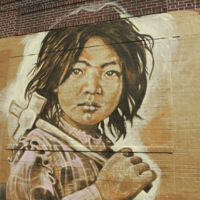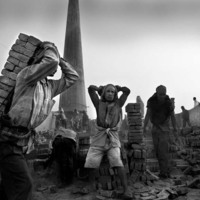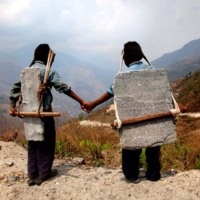
Manon
Mica is a mineral that provides the sparkling effect in cosmetics and car bodypaint. The mica mining area of Jharkhand/Bihar in India comprises an estimated 300 rural villages, and child labour occurs in these remote villages, including collecting/mining mica and cobbing (hammering minerals other than mica from the mined rocks. It is estimated that approximately 20,000 children are currently working in the mica mines in India, with 90% of these working under illegal conditions of modern slavery. Manon was trafficked from Nepal to India at the age of 6 years old to work in the Mica mine. Forced to work in dangerous conditions, and to watch his best friend die, Manon was finally rescued two and a half years later.

Menuka
Lebanon is a destination for Asian and African women trafficked for the purpose of domestic servitude, and for women from Easter Europe for commercial sexual exploitation. There are estimated 200,000 migrant domestic workers in Lebanon and until 2012, Lebanon was the top country of destination for female migrant workers from Nepal. Women who travel to Lebanon legally to work as household servants often find themselves in conditions of forced labour through the withholding of passports, non-payment of wages, restrictions on movement, threat and physical of sexual assault. Menuka was looking to support her family when she decided to travel from Nepal to Lebanon to find work. Upon arrival in Lebanon, Menuka’s passport was taken from her and she was taken to provide domestic work for a family.

Savitra
Lebanon is a destination for Asian and African women trafficked for the purpose of domestic servitude, and for women from Easter Europe for commercial sexual exploitation. There are estimated 200,000 migrant domestic workers in Lebanon and until 2012, Lebanon was the top country of destination for female migrant workers from Nepal. Women who travel to Lebanon legally to work as household servants often find themselves in conditions of forced labour through the withholding of passports, non-payment of wages, restrictions on movement, threat and physical of sexual assault. Savitra was having family problems in Nepal when she decided to go to an agency who acquired her work in Nepal. Upon arrival she went to work as a domestic worker for two different employers, however found it difficult to learn the tasks required of her and was sent back to the agency in Lebanon. Rather than being allowed to return home, Savitra was told she would have to struggle in Lebanon for one or two years to pay back the debt incurred from her travel. While she was eventually placed with a nicer employer who provided her with food, accommodation and clothes, she was still unable to leave her employer’s house

Aakash
Foreign workers constitute more than 20 percent of the Malaysian workforce and typically migrate voluntarily—often illegally—to Malaysia from Bangladesh, India, Nepal, Burma, Indonesia, the Philippines, and other Southeast Asian countries, mostly in pursuit of better economic opportunities. Some of these migrants are subjected to forced labour or debt bondage by their employers, employment agents, or informal labour recruiters when they are unable to pay the fees for recruitment and associated travel. Aakash, 24, from Nepal, became trapped in debt bondage in the electronics industry in Malaysia.

Deependra
Migrant workers from Asia and Sub-Saharan African continue to flock to the Middle East for work. Migrant workers are subject to practices that may amount to forced labour including extortionate recruitment fees, illegal confiscation of identity documents, withholding and non-payment of salaries, hazardous working conditions, unhygienic living conditions, unlawful overtime performed under the threat of deportation, and physical and sexual abuse. In 2015 an IOM and Walk Free study of 162 exploited migrant workers from Iraq, Jordan, Lebanon, Egypt and Saudi Arabia, 100% of workers had their identity documents withheld, 87% were confined to their workplace and 76% had their wages withheld. Deependra Giri was looking for work when he was offered a job with a good salary in Qatar as a clerk. Upon arrival, Deependra's passport was confiscated and he was taken to an industrial area where he was forced to undertake manual labour. Due to the Kafala system in Qatar, Deependra was committed to his contract and was unable to leave the country. After completing his 2-year agreement Deependra managed to convince his employer to allow him to go home for 2 weeks to see his family. Once back in Nepal, Deependra informed his manager that he would not be returning.

Child Labor in Katmandu, Nepal
Indira works in a granite quarry near Katmandu. She is 7 years old. The granite is sent to Britain to provide stone tiles for patios. Children are paid the equivalent of 25 cents a day to perform tiring and dangerous work with little or no safety gear. Approximately 32,000 children in Nepal work in stone quarries. Some are as young as 5 years old Many work besides their parents who are in debt bondage with little hope of escaping. Some live at the work site which is watched by guards who forbid them from leaving. The children are forced to perform hazardous jobs and if they refuse the employer withholds food from the family. Eradicating child labor from Nepal is difficult because it is fundamental to the economy. This mural was painted in conjunction with the 6th Annual Welling Court Mural Project in Astoria, Queens. It is located on 12th Street in between Welling Court and 30th Rd.

Carriers, Nepal
Entire families are in bonded labor slavery. Often, families get a loan for an emergency or to pay a broker a fee for getting hired on a new job. Slaveholders, the only people near with any money to lend, trick the borrowers into slavery through illegal, exorbitant interest rates that are impossible to repay. Children inherit the bogus debt from their parents. Generations of families have been enslaved for a loan of just $18.

Brothers Carrying Stone, Nepal
Each day, children make several trips down the mountain, delivering stones from higher up in the Himalayas. They use makeshift harnesses out of ropes and sticks, strapping the stones to their heads and backs. Many of them come from families where everyone is trapped in debt bondage slavery. One of the mothers describes what it was like to be in slavery, “Neither can we die, nor can we survive.”